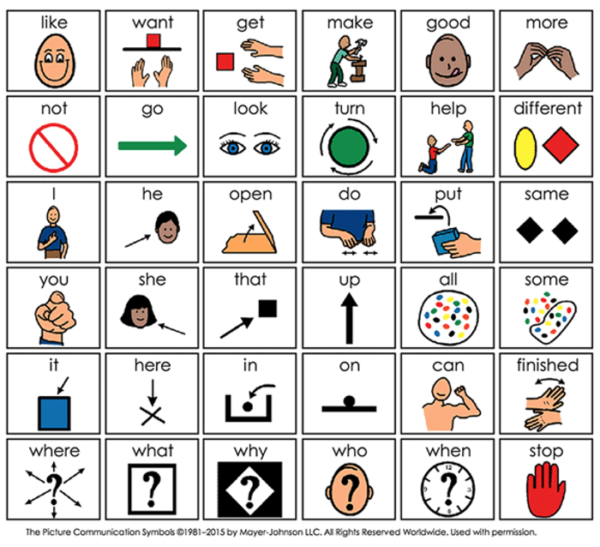By: Kaylen Alford, MS, CCC-SLP
Core words are simple, frequently used words that make up more than 80% of our spoken language. They are consistent across age groups, people, activities, places, and topics, and can be used to build functional and meaningful language interactions. Core words are the foundation of language for nonverbal children, as well as for verbal language learners. While your child is also building a repertoire of fringe words (meaning nouns – i.e. shapes, colors, animals), it is also important to learn and use core words in conjunction with these fringe words to create expanded, meaningful utterances.

Using Core Words
Your child may be learning or identifying colors, so a great way to reinforce their expressive communication is to model comments or requests within activities involving colors (art, play activities). An example of core words/phrases you could model include: “where is purple?,” “put in purple,” “want purple?” “no more purple,” “help open purple,” “purple is on,” etc. While the word “purple” is specific to the activity, the core words surrounding this target word create meaning.
Core words are also beneficial in building your child’s receptive language skills. For instance, your child frequently learns new vocabulary in school. One way you could implement core word usage is by describing the new vocabulary terms using core words. Asking comprehension questions that are descriptive (open-ended), rather than referential (close-ended) is also beneficial. Below are a couple examples of referential and descriptive questions.
Referential
Q: Name the 3 states of matter. (A: solid, liquid, gas)
Descriptive
Q: Describe something solid (A: something hard, keeps its shape)
Referential
Q: Was the Tyrannosaurus a herbivore, omnivore, or carnivore? (A: carnivore)
Descriptive
Q: What does the Tyrannosaurus eat? (A: eats meat, eats other animals)
Descriptive teaching allows for expanded responses of words that are meaningful and can be used across a variety of contexts and environments. This approach focuses on using high frequency, core vocabulary, which is already available in the child’s AAC system. I have found that having a visual representation of core words is also helpful for language development. There are several layouts of boards (link below) that would be a great starting point as you begin to learn and use these words with your child.
Helpful Links
- Core word boards (by Project Core)
- Activity ideas can be found HERE
- You can find a variety of free online books including core words HERE
- Descriptive & Referential Teaching Handout
- This online dictionary is handy when creating simple, core word based definitions https://www.ldoceonline.com/
- Word lists can be found HERE
If you would like more information about Core Words, including what they are and how they can be used to foster your child’s speech and language development, Schedule a free 15 minute phone consultation with Kaylen today










